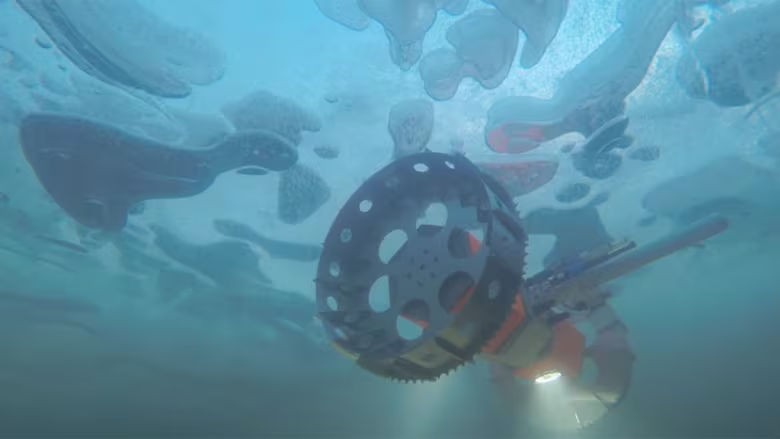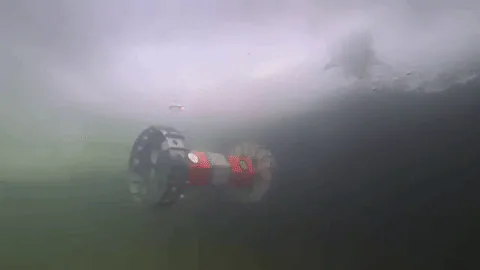NASA's building a robot to explore Jupiter's moon Europa — from underneath its icy shell
The buoyant robot will 'drive' upside down on the undersurface of Europa's ice

Researchers from NASA's Jet Propulsion Lab are testing a new robot under the ice in Antarctica, to see if it can handle conditions on ice-covered moons like Europa and Enceladus.
Ultimately, it would be used to explore these potential water worlds in the search for life. During these recent tests, Earth-based life certainly found the robot interesting.
"Fish would actually swim up to us, somewhat investigating," lead engineer Andy Klesh told Quirks & Quarks host Bob McDonald.
"The Adélie penguins would come from all around to see what was going on, come and check out the rover, look at the wheels, try and figure out, 'What is this beast?'"

The "beast" was a metre-wide robot called BRUIE, which stands for Buoyant Rover for Under-Ice Exploration. It is an early prototype of a device that might be sent to explore Jupiter's icy moon, Europa, in the coming decades.
Its basic principle is that it will drill down through the ice to Europa's ocean. From there, its buoyancy would hold it to the undersurface of the ice. The robot has two wheels that would then allow it to drive around 'upside down' on the undersurface of Europa's icy shell.
Klesh and his team started working on BRUIE in 2012, and they are still in the early stages of building a robot that can withstand the icy moon's extreme conditions. Not only would their robot have to survive the long journey to Europa and the descent down to its surface, it would then have to make it somehow through the 20-kilometre thick ice sheet to start its mission.
"This is only an early precursor mission to what we might be able to do," said Klesh.
Searching for life
Scientists are all but certain that Europa has liquid water under its icy shell, and if it does, it would hold three times as much liquid water as all of the oceans on Earth. Astrobiologists generally consider liquid water to signify at least the potential for life.
"It's one of the most promising locations in our solar system for where we might find other signs of life," said Klesh.

Of course, a wheeled vehicle might seem like a strange choice for exploring an ocean. But the best place to look for life is where the ice and water meet, which means a submarine just won't cut it.
"We always tend to see life form on interfaces like the ice-water interface," said Klesh. "With the rover, we can almost silently drive up to it, turn our cameras upwards and we're looking right at that area with no power use to stay in place."
Its buoyancy and spiked wheels mean BRUIE is designed to stick to the underside of the ice sheet, so that it's not at the mercy of any currents that might threaten to knock it off its course. It can freely roam the underside of the ice to see what might be growing there.
In Antarctica, aside from the fish and penguins, they were able to get a close-up look at the algae mats growing under the ice, and measure the amount of oxygen that they were producing.

"Algae and microbes tend to use photosynthesis and actually anchor on that underside of the ice where they themselves can be protected from the currents that are around there in the air," said Klesh. "Certainly there won't be a lot of light [on Europa], but there will still be that anchoring point for many of the different microbes.
"So we're still learning about what types of life forms, what are the signs of life that we might find on the underside of the ice."
Craters and crevasses
In Antarctica, the team tested the robot's mobility to see if it could easily move around underneath the glaciers and ice sheets. They quickly found that the undersurface of the ice there is a lot more challenging than they'd expected.
"We thought at first, 'Oh, it will be perfectly flat, will be very easy to drive a rover around,'" said Klesh. "But what we found is sometimes that we have craters similar to what you might find on the moon, crevasses that you can actually fall upwards into."

So now, they're designing ways to deal with these hazards.
"We're looking at options for it to actually hop, to use thrusters to jump from one spot to another, and how to get it out of these fairly unfortunate spots that we still want to be able to traverse across," Klesh said.
The team's next step will be to test BRUIE's capabilities to explore for weeks and months under the ice from a remote location.
Building the robot rover may be the smaller part of the challenge of exploring Europa's oceans. NASA engineers are only just beginning to work out how how to drill down through Europa's 20-kilometre thick ice sheet to get BRUIE where it needs to go.
But Klesh's team is working on making BRUIE much smaller to make that task easier.
"We've actually worked on one that can slim down, that the wheels can collapse and the tail can fold in, so we can fit into about a 20-centimetre diameter hole and be that much easier to get underneath the ice," he said.
Produced and written by Amanda Buckiewicz